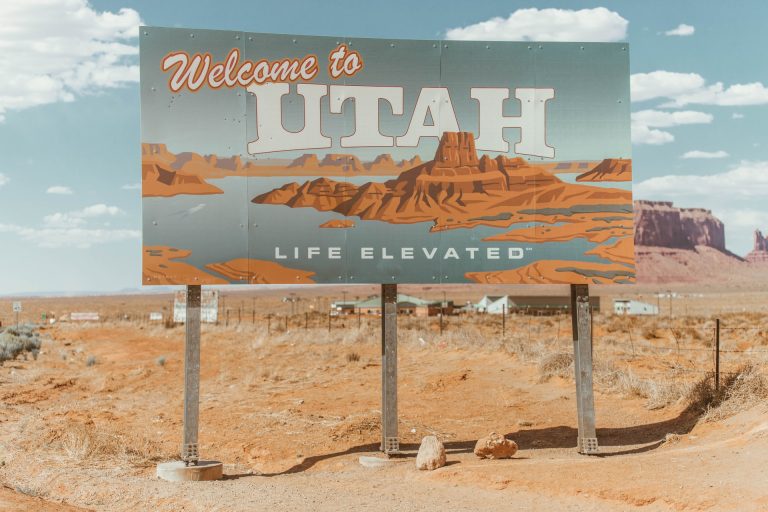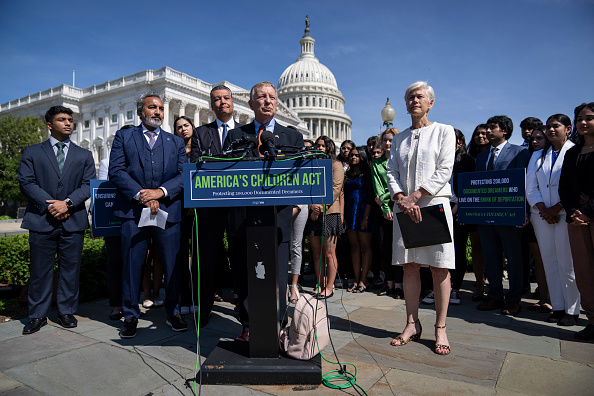
Every year, Felipe Sousa-Lazaballet and his colleagues at Hope Community Center on the outskirts of Orlando, Florida, take high school students on out-of-state road trips to visit college campuses. The immigrant-focused non-profit delivers a range of social services and a proud hallmark is their robust youth program. “Our goal is to actually get kids into college,” says Sousa-Lazaballet. “So, we start them young, we get them in school, we support them through their journey, we give them scholarships, and we take kids to see college campuses.”
But a new state law could put an end to such excursions. Among the many provisions included in Florida SB 1718, which was signed into law in May, transporting an undocumented immigrant into the state is now a third-degree felony. “If, for example, we took a kid to see Georgia Tech, we are running a risk of becoming felons,” says Sousa-Lazaballet, who underscores that it’s against Hope’s policies to ask anyone about their immigration status.

The same law applies not just to organizations like Hope but also to individuals — including friends and family members. “If I take my family member on a road trip to Georgia,” says Sousa-Lazaballet, “upon returning, I’m running a risk of getting a felony and being in jail from five to 15 years.”
Such a consequence can make it nearly impossible for mixed-status families to travel out of state. “Mixed status within families is really quite common,” says Sousa-Lazaballet. “Immigration status is not stagnant. You could be undocumented, then start some process, then have some sort of quasi-status, like Temporary Protected Status or DACA. It’s not something that in a person’s lifetime stays the same.”
While Florida SB 1718 might be one of the most high-profile pieces of state action on immigration policy, it’s hardly an exception. Stasis on this front at the federal level has spurred a rash of increasingly bold immigration legislation at the state level. “What we’re seeing is a direct challenge to what has been now for several decades, even centuries, a well-established idea that only the federal government engages in admissions and removal and immigration enforcement,” says Pratheepan Gulasekaram, a professor at the University of Colorado Law School who specializes in the relationship between state and federal jurisdiction when it comes to immigration law.
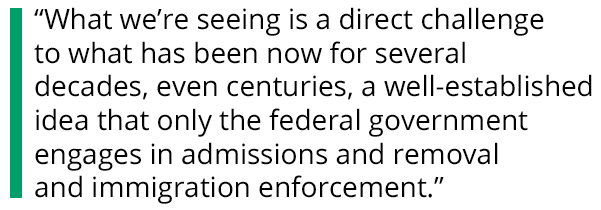
The idea that the federal government alone engages in immigration admissions, removal and enforcement has been confirmed by several fundamental court cases, including Hines v. Davidowitz, which in 1941 established that the supremacy clause of the U.S. Constitution invalidates, or preempts, state laws that interfere with or are contrary to federal law. The decision states:
… the regulation of aliens is so intimately blended and intertwined with responsibilities of the national government that where it acts, and the state also acts on the same subject, the act of Congress or treaty is supreme; and the law of the state, though enacted in the exercise of powers not controverted, must yield to it. And where the federal government, in the exercise of its superior authority in this field, has enacted a complete scheme of regulation … states cannot, inconsistently with the purpose of Congress, conflict or interfere with, curtail or complement, the federal law, or enforce additional or auxiliary regulations.
But Florida SB 1718 and numerous other state laws and municipal ordinances are now directly challenging this established legal doctrine. What’s behind this flurry of activity on the state level? What are the constitutional questions this dynamic raises? And what does this all say about the future of immigration policy in the U.S?
***
Throughout its first 100 years, the United States did not have border control or immigration policy. From 1776 until 1875 there was no federal regulation of the borders. During that period several states and localities developed their own immigration policies. Ports of entry in prominent states like New York, Delaware, Louisiana, and California established regulations that stopped people from crossing over into that jurisdiction based on several conditions such as a quarantinable disease and poverty — several states instituted “pauper laws.” Some regulations required a bond to be paid by a ship’s captain before passengers were allowed to disembark.
In his oft-cited paper, “The Lost Century of American Immigration Law,” Harvard Law School’s Gerald Neuman argues that these state and local laws were essentially the immigration laws for the country’s first 100 years. They operated as a form of border control, and included not just regulations for ports of entry but also statutes like the fugitive slave laws.

In 1875, California established a law that empowered the state commissioner to single-handedly decide which immigrants would be allowed to disembark from ships. The law referenced barring “lewd women” from coming into the state, a move that was, essentially, understood as an act to bar Asian women from coming into the country, as xenophobic fears about the state’s growing Asian population spread among the dominant white population. But the federal court system struck down this law later that same year in Chy Lung v. Freeman, laying out, for the first time, the legal rationale that enforcement of immigration laws and admissions regulation is solely the province of the federal government.
But the political pressure from the burgeoning state of California remained intense; after striking down the state law prohibiting the entry of certain women, the federal government passed the Page Act, which essentially established the same entry regulations — not just for California but for the country. That legislation was followed seven years later by the 1882 Chinese Exclusion Act, which barred entry of nearly all Chinese nationals. “One of the things that happens in that time period,” says Gulasekaram, “is that state and local governments, as well as the courts, start to read that exercise of federal power as essentially excluding state and local admissions regulations.”
Chy Lung v. Freeman spurred the robust entry of the federal government into the regulation of admissions and deportation as exclusively a federal enterprise. “That’s why states don’t have their own visa systems,” says Gulasekaram. “They don’t have their own work employment systems. They don’t run their own deportation schemes.”

For the next 90 years, the federal government established various immigration laws with little or no interference from states. This began to change after the Immigration and Nationality Act of 1965, which established the framework for our present-day immigration system.
One of the key features of the 1965 law is the idea that immigration from all over the world should be treated equally. Caps on immigrants from certain countries, which had been based in racist ideology, were thrown out. In 1965, immigration to the U.S. opened to individuals from all over the world with every country getting similar caps, regardless of their population or their historical and geographic relationship to the United States.
“It’s into the early ’70s,” says Gulasekaram, “when the modern concept of the unlawfully present, non-citizen — or illegal immigrant, as some people would call it — begins.”
***
It didn’t take long for states to begin challenging the 1965 framework. In 1975, Texas law forbade undocumented minors from going to public elementary schools. But in 1982, the Supreme Court determined in Plyler v. Doe that the law was a violation of the United States Constitution, specifically its equal protection guarantee, and Texas was forbidden from barring unlawfully present children from attending public schools.
In 1994 it was California attempting a resurgence of state level intrusion into the deterrence of immigration with Prop 187. At the time, California was in a recession and Proposition 187, a ballot initiative, established a state-wide system of screening for citizenship and prohibiting undocumented immigrants from accessing public education, non-emergency health care and other services. But the proposition was struck down in federal court on constitutionality issues days after it passed. The state carried out a five-year appeal of the decision, before Governor Gray Davis ended the appeal in 1999.

After Plyler v. Doe and Prop 187, there was a retrenchment of sorts with state and local initiatives related to immigration admissions, removal and enforcement. This dynamic was reinforced by 9/11 when both parties, by and large, accepted that border security had suddenly become a subset of the newly framed “Homeland Security.” The established legal doctrine that immigration policy is in the hands of the federal government was, perhaps, more firmly entrenched than ever.
That is, until the election of Barack Obama, which prompted the rise of the Tea Party and strong anti-immigrant sentiments throughout the country, particularly within the Republican Party.
In 2011, Alabama attempted a variation on Texas’s 1975 law. Instead of directly prohibiting unlawfully present children from attending public schools, the Alabama legislation directed the state to collect the immigration status of all students attending public schools. Within days of the legislation being passed, student enrollment, particularly in agricultural parts of the state, dropped precipitously. The law was eventually struck down in federal district court, with Plyler v. Doe as the legal foundation, and Alabama declined to appeal the decision to the Supreme Court.
In that same period, Arizona passed SB 1070, which had numerous provisions pertaining directly to immigration enforcement, the most notorious of which was the requirement that all non-citizens 14 years old or older register with the U.S. government and carry documentation at all times or risk deportation. Prof. Gulasekaram describes SB 1070 as “the cutting edge, the most robust attempt at state immigration enforcement in a long time.”
But in a 2012 ruling, the Supreme Court turned back most of the provisions in the law, upholding just one, which was later settled out of court by the Arizona attorney general. That 2012 decision affected efforts to pass similar legislation in other states, including Utah, Indiana, Alabama, Georgia, and Florida. In the wake of Arizona, all of those efforts were struck down by various federal courts.
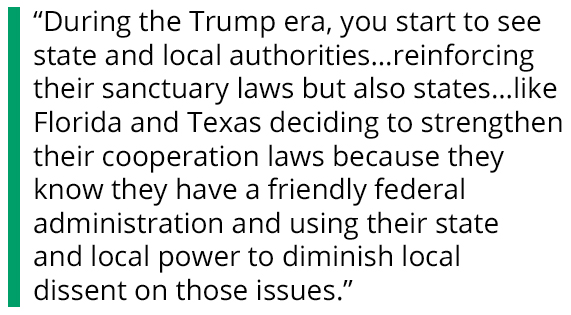
Five years later, the Trump administration spurred a new round of municipal and state efforts to establish immigration laws. “During the Trump era, you start to see state and local authorities becoming much more vocal, reinforcing their sanctuary laws,” says Gulasekaram, “but also states and localities like Florida and Texas deciding to strengthen their cooperation laws because they know they have a friendly federal administration and using their state and local power to diminish local dissent on those issues.”
***
Under the Biden administration, with a divided Congress locked in a stalemate on immigration reform, the spirit of dissent at the state level has gained more momentum.
Not to be outdone by Florida SB 1718, Texas Governor Greg Abbott launched Operation Lone Star in March of 2021, an initiative of the state executive branch. The program has several components, including the appointment of a state “border czar” and, most notably, the application of state trespassing and harboring statutes to undocumented immigrants and those who transport undocumented immigrants. While Operation Lone Star does not create a new crime under state law pertaining to undocumented immigrants, the stated intent of the program makes clear that Texas is using existing statutes for immigration enforcement.
“It’s hard to understand this as anything but very direct, very stark challenges to what has now been accepted wisdom with regards to federal authority and even Supreme Court precedent on immigration enforcement,” says Gulasekaram. “For modern immigration regulation, a lot of the things that Texas is doing are unprecedented.”
Texas has made Operation Lone Star a central priority, spending more than $4 billion dollars on the program to date. There are also proposals in the Texas legislature to create a state border enforcement force and to create state immigration laws for unlawful entry and unlawful presence. Related assertions of state powers have occurred in jurisdictions far removed from the southern border. In May, Idaho Governor Brad Little announced he would be sending state troopers to help secure the border in Texas. Similar pledges have been made by other governors of non-border states.

While these efforts at the state level are described by Gulasekaram and other legal experts as directly confrontational, there are more cooperative models for state, county, and municipal action with regards to immigration admissions, enforcement, and removals.
Earlier this year, the city of El Paso was hit with unusually large waves of immigrants. “We had up to 2,500 people on the streets, close to one of the bridges in an area by a church called Sagrado Corazon,” says city spokesperson, Enrique Duenas Aguilar. “They were people who had already been released from Border Patrol to us.” Aguilar, who has worked for the city for more than eight years, says he had never seen numbers anywhere near what they were seeing in the winter and spring. “Being a border town, immigration has always been something here. Before, Border Patrol will be able to get everyone and just process them to their own means. But we started seeing people on the streets. So we have to spring into action.”
The city took several proactive steps to deal with the sudden influx. Mayor Oscar Leeser requested FEMA funding for sheltering the immigrants and for finding them more long-term housing. Using those federal funds, Mayor Leeser and his staff set up a shelter using an empty public school facility. They also set up a migrant processing center to help troubleshoot housing solutions for the immigrants, almost all of whom had made asylum claims and were facing several months, perhaps a few years, before having their cases decided.
“We started asking all the migrants, ‘Where’s the city you’re looking to go to?’ Or, ‘What’s that region?’” says Aguilar. “Most of them wanted Chicago or New York. So we could help those people get to either transportation hubs or the closest city to where they were going. A lot of these migrants have their own means, they just simply don’t know how to move within the country. Sometimes they have never bought a plane ticket before. So we had a staff that was helping them purchase these tickets. We helped them contact, over the phone or email, their family members. Sometimes family members will even send tickets to us, we’ll print them out. We’ll then transport the people to the airport so they could move out of the city.”
El Paso also started chartering buses because of the limitations of the city’s airport, which offers only 55 flights per day. “There’s about 500 seats available and not all of them are going to where the immigrants are going. We established a chartered bus program, so we could help them get to their destination or at least to a transportation hub.”
The programs instituted by El Paso, using federal funds, were successful in reducing the sheltered immigrant population to 80 people, and Aguilar says that all of the built-out infrastructure has the city well-positioned to deal with any future surges in border crossings.
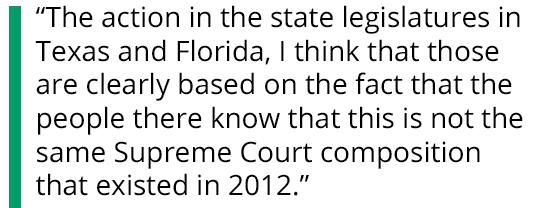 Notwithstanding the success of the El Paso model of assertive, cooperative policies, it’s the more confrontational busing programs that have garnered much of the national press. In April of 2022, Governor Abbot used state funds to start busing immigrants to other cities, including New York, and in September of 2022, Governor DeSantis made headlines by flying migrants to Martha’s Vineyard, following up on a suggestion made by former Fox News host Tucker Carlson. The marked difference from the El Paso program is that Governors Abbot and DeSantis did not coordinate the transportation of immigrants with the receiving cities, and there was little or no communication with the immigrants themselves. Many of the individuals who Governor DeSantis sent to Martha’s Vineyard have stated publicly that they were lied to about where they were going.
Notwithstanding the success of the El Paso model of assertive, cooperative policies, it’s the more confrontational busing programs that have garnered much of the national press. In April of 2022, Governor Abbot used state funds to start busing immigrants to other cities, including New York, and in September of 2022, Governor DeSantis made headlines by flying migrants to Martha’s Vineyard, following up on a suggestion made by former Fox News host Tucker Carlson. The marked difference from the El Paso program is that Governors Abbot and DeSantis did not coordinate the transportation of immigrants with the receiving cities, and there was little or no communication with the immigrants themselves. Many of the individuals who Governor DeSantis sent to Martha’s Vineyard have stated publicly that they were lied to about where they were going.
“Florida is a state that has traditionally welcomed immigrants and refugees and asylum seekers,” says Felipe Sousa-Lazaballet. “That’s the whole story of the Cuban community. Some of them arrived very much like the unaccompanied minors arriving now, kids who left Cuba without their parents.” Sousa-Lazaballet points out that this immigrant identity is woven into the political identity of the state: former U.S. Senator Mel Martinez arrived in Florida as part of Operation Peter Pan, which provided safe passage and residency status for 14,000 Cuban minors in the early 1960s.
But the political make-up in Florida and other states has changed dramatically since the presidency of George W. Bush, the last Republican administration to pursue comprehensive immigration reform. Perhaps more important, the composition of the Supreme Court has changed as well. “The action in the state legislatures in Texas and Florida, I think that those are clearly based on the fact that the people there know that this is not the same Supreme Court composition that existed in 2012,” says Gulasekaram.
The 2012 decision that struck down most of Arizona SB 1070 was written by Justice Anthony Kennedy and supported by Justices Ginsburg and Breyer. All three are no longer on the court and have been replaced with more conservative justices — some of whom have already shown a willingness to test conventional legal doctrine when it comes to the federal government’s exclusive purview over immigration policy.
 In the 2020 Kansas v. Garcia decision, the Supreme Court determined it was okay for Kansas to prosecute non-citizens for using fraudulent social security numbers in gaining employment. “Prior Supreme Courts would’ve been tempted to look at that situation and come out the same way as Arizona v. United States,” says Gulasekaram. “Which is to say the regulation of unauthorized employment in the United States is something that the federal government has done through the immigration statutes, and state level involvement in regulating unauthorized employment should not be allowed. In part due to the changing Court composition, in 2020, one of the things that Kansas v. Garcia says is these aren’t statutes created for the purpose of immigration enforcement. Sure, they’re being applied against unlawfully present non-citizens and yes, it’s in the context of them applying without authorization for employment. Nevertheless, we allow the state to have concurrent jurisdiction here. They can also enforce their laws, even if it happens to overlap in many ways with what the federal government might do with its immigration control laws.”
In the 2020 Kansas v. Garcia decision, the Supreme Court determined it was okay for Kansas to prosecute non-citizens for using fraudulent social security numbers in gaining employment. “Prior Supreme Courts would’ve been tempted to look at that situation and come out the same way as Arizona v. United States,” says Gulasekaram. “Which is to say the regulation of unauthorized employment in the United States is something that the federal government has done through the immigration statutes, and state level involvement in regulating unauthorized employment should not be allowed. In part due to the changing Court composition, in 2020, one of the things that Kansas v. Garcia says is these aren’t statutes created for the purpose of immigration enforcement. Sure, they’re being applied against unlawfully present non-citizens and yes, it’s in the context of them applying without authorization for employment. Nevertheless, we allow the state to have concurrent jurisdiction here. They can also enforce their laws, even if it happens to overlap in many ways with what the federal government might do with its immigration control laws.”
For Gulasekaram, it’s not hard to see how the legal thinking in Kansas v Garcia could be applied to several provisions in Florida SB 1718, including mandates for hospitals to collect the immigration status of patients and the prohibitions on county’s issuing their own identification cards to immigrants — something that can be crucial for working and surviving while waiting for an asylum case to be heard.
“Before the legislative session started, the Hope Community Center was actually leading the efforts here in Orange County to pass something called Community IDs,” says Felipe Sousa-Lazaballet. “The county would give a grant to a nonprofit organization, in this case Hope, to issue these IDs. We’ll make sure that there isn’t any fraud, issue the IDs and with the help of the county, we get other organizations, like banks and businesses, to accept the ID. It had already passed in Miami-Dade County, Broward, Palm Beach, and Alachua County. This was something that we were going to pass. We had the votes to pass, but everything got taken back because the immigrant bill actually included a ban on the funding for Community IDs.”
Gulasekaram and other legal experts agree that these and other provisions in Florida SB 1718, as well as in Operation Lone Star, are well-positioned to survive legal challenges and, perhaps, reshape how we think about state authority when it comes to immigration policy. Gulasekaram singles out Justice Samuel Alito as taking a leading role in making this shift. In his dissent regarding the Arizona v. United States decision, Alito argued that Section 6 of the Arizona law, which allowed a police officer to arrest someone without a warrant if the officer believed that the arrested individual had committed a crime that could cause him to be deported, was not preempted by federal law because it “adds virtually nothing to the authority that Arizona law enforcement officers already exercise. And whatever little authority they have gained is consistent with federal law.”
The Alito dissent presaged a shift in judicial thinking — and it’s a shift that some believe has been reinforced since 2012. “The voice that’s going to be heard on immigration enforcement matters hues very close to, if not identical, to Justice Alito’s dissent in Arizona v. United States, and then now in majority in cases like Kansas v. Garcia.”
***
For nearly 150 years the federal government has operated with exclusive authority when it comes to immigration admissions, enforcement and removals. And for the past 58 years, the government has carried out these responsibilities under the Immigration and Nationality Act framework. Despite how antiquated the system has become, the Supreme Court has consistently beat back state and local efforts to establish their own immigration policies.
 But a new constellation of Supreme Court justices has already demonstrated a willingness to upend long-standing legal doctrine on other complicated issues such as abortion, executive branch rule-making, and affirmative action. Governors and state legislators, eager to put their mark on immigration policies, seem convinced that the highest court in the land is also ready to upend legal doctrine on immigration. Recent decisions such as Kansas v Garcia seem to support such a conviction. “Operation Lone Star and Florida SB 1718 almost certainly push the boundaries of what states and localities are allowed to do,” says Gulasekaram. “You have an immigration enforcement arms race between DeSantis and Abbott. Trying to see who can outdo the other with regards to the most Draconian restrictionist policies on immigrants and unlawfully present immigrants in particular.”
But a new constellation of Supreme Court justices has already demonstrated a willingness to upend long-standing legal doctrine on other complicated issues such as abortion, executive branch rule-making, and affirmative action. Governors and state legislators, eager to put their mark on immigration policies, seem convinced that the highest court in the land is also ready to upend legal doctrine on immigration. Recent decisions such as Kansas v Garcia seem to support such a conviction. “Operation Lone Star and Florida SB 1718 almost certainly push the boundaries of what states and localities are allowed to do,” says Gulasekaram. “You have an immigration enforcement arms race between DeSantis and Abbott. Trying to see who can outdo the other with regards to the most Draconian restrictionist policies on immigrants and unlawfully present immigrants in particular.”
Such political dynamics could very well be taking the country into uncharted territory with regard to how we develop policies around immigration admissions, enforcement and removal. Such a shift will clearly have an impact on migrants, but, as Sousa-Lazaballet points out, the shift has the potential to affect American society writ large: “The idea that you could target just an undocumented person is really quite impossible because as you’re going for it, you are also bringing the entire family and then the community because folks work and they’re going out to, say, a restaurant, construction site, whatever it may be, agriculture. If they’re not there, then that work doesn’t get done. So, it ends up affecting everyone.”
If an endgame at the Supreme Court is the most likely way out of the federal government’s paralysis on immigration policy, then for those who are looking for more liberal policies, like Sousa-Lazaballet and his colleagues, relying on conventional legal doctrine is untenable. Immigration activists will either have to develop a similarly aggressive approach to shaping policy at the state level, or harness the shift in the judicial branch to provoke long-overdue lawmaking in Congress. But the time for federal consensus on immigration policy could very well be narrowing. For the foreseeable future, a fractured landscape of discrete state policies seems poised to play a role in who gets to enter and stay in the country.
Read More:

Capitol Hill Briefing No. 1
